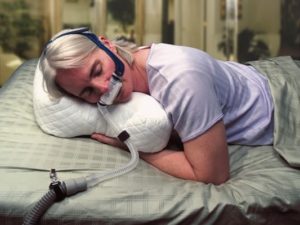Blog
The Health Dangers of Dirty CPAP Equipment

If you are one of the estimated 18 million adults in the United States who suffers from sleep apnea, then you may use a CPAP machine on a nightly basis to help control your sleep apnea symptoms. This machine can be a great asset to your health because it helps you get the deep sleep you need at night despite your medical condition.
However, it is important to understand the health risks of using a CPAP machine that is not sanitized on a regular basis, as well as the health risks of not following CPAP care instructions precisely. Read on to learn about the health hazards of using dirty CPAP equipment and how to keep all of your CPAP equipment sanitary to avoid these hazards.
How Dirty CPAP Equipment Can Endanger Your Health
Your CPAP machine is made up of many parts: the main CPAP machine, humidifier, humidifier water chamber, tubing, and mask. All CPAP machine parts that come into contact with water vapor — created by either your humidifier or your breath — can become a breeding ground for bacteria, mold, and yeast when not regularly disinfected. All of these pathogens thrive in warm, moist environments, like inside your CPAP equipment.
When your CPAP equipment becomes contaminated with these pathogens, you can inhale them when you use your equipment, and this can lead to many health problems.
When inhaling moist air that is contaminated with mold, bacteria, and/or yeast through your CPAP machine, it can lead to the following health problems:
- Sinus Infections
- Respiratory Infections
- Pneumonitis
- Pneumonia
- Cough
If you suffer from asthma, then inhaling these pathogens can also trigger asthma symptoms and even attacks. In addition, natural oils and bacteria present on your skin can build up on your CPAP mask and cause skin irritation or even infection.
How to Avoid These Health Hazards
Thankfully, these health hazards can be avoided by following good CPAP hygiene practices.
Never Use Tap Water in Your Humidifier Water Chamber
While you may know that you should use only distilled water in your water chamber, you may run out from time to time and decide to use tap water in a pinch. However, all tap water contains the minerals calcium and magnesium, and filling your water chamber with tap water can cause mineral scale to build up in it. Mold can then grow in this mineral scale and enter your air supply when you use your CPAP machine humidifier.
Choose Heated CPAP Tubing
You may know that using heated CPAP tubing is important for keeping the air that your humidifier warms up from cooling off before you inhale it. However, you may not realize that heated tubing prevents condensation from developing in your breathing tube. When there is less condensation in your breathing tube, it discourages mold and bacteria growth in it.
Replace CPAP Filter Regularly
It is very important to replace your CPAP filter on the schedule recommended by the manufacturer or even more often if you suffer from allergies. Replace disposable filters at least once a month and replace reusable filters at least every six months, while cleaning them once a month.
This filter removes allergens from the air in the room you sleep in before you inhale it. When not replaced regularly, this filter not only doesn’t remove these allergens as effectively but also becomes contaminated with bacteria over time.
Clean and Replace Masks & Cushions Often
To avoid skin irritation and potential infection, you should wash your CPAP mask with mild soap and water or specialized mask cleaners at least once a day to keep it clean and sanitary. However, your CPAP masks and cushions are not meant to be used indefinitely without replacement, even when you clean them properly.
Your CPAP cushion should be replaced at least every three months and your entire mask should be replaced every six months unless your device manufacturer states otherwise.
Never Leave Water in Humidifier Water Chamber
You may be tempted to leave water in your humidifier water chamber between CPAP uses to conserve distilled water. However, it is very important to dump all water out of this chamber daily, cleanse it with soap and water, then dry it thoroughly to keep it from becoming a breeding ground for pathogens.
Disinfect Your CPAP Equipment Weekly
You should disinfect all of your CPAP equipment, including your CPAP tubing, humidifier water chamber, and mask, at least once a week, to remove any contaminants that do end up accumulating on these items. Even the items that you clean daily with soap and water need to be disinfected weekly since soap and water will not remove all contaminants.
To disinfect these items, soak them in a solution of three parts distilled water to one part white vinegar for about 15 to 20 minutes. Next, rinse them thoroughly with distilled water (never tap or filtered water) and allow them to dry thoroughly before reassembling your CPAP system.
Alternatively, you can sanitize your CPAP equipment with one of the new automatic CPAP sanitizers on the market to make this process quicker and easier.
If you use a CPAP machine to control your sleep apnea, then be sure to remember the health hazards of dirty CPAP machine and sanitize and replace your CPAP equipment on a regular basis to protect your health.
Questions?
If you have questions about your CPAP mask or equipment, you can speak with customer service or one of our Corner Home Medical respiratory therapists at 1-866-535-5335.
